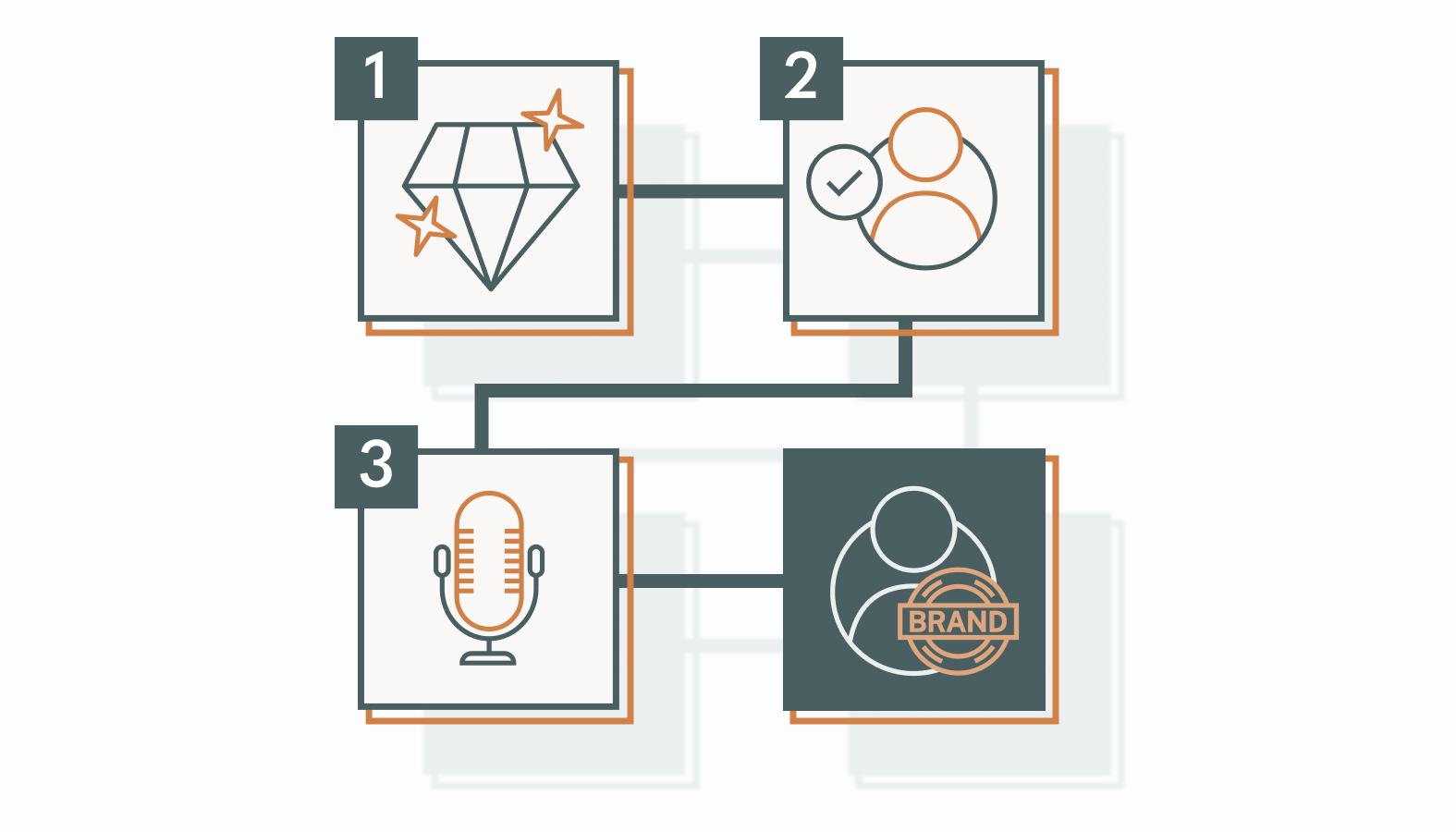Cutting through the digital noise takes more than just being present. With countless voices vying for attention, the real challenge is making an impact consistently, memorably, and with authority.
That’s where a strong personal branding strategy comes in.
Defining your unique value, connecting with the right audience, and creating a brand that genuinely resonates are needed to unlock influence, opportunity, and long-term success.
This guide breaks it down with a strategic approach to branding that gets you noticed, builds trust, and drives real impact that translates to career advancement, increased opportunities, and industry recognition.
Ready to rise above the noise and position yourself as the go-to expert in your field? Let’s get started.
Define Your Target Audience
Standing out in a crowded market starts with knowing exactly who you are talking to. The best messaging, branding, and marketing strategies are built on a crystal-clear understanding of your ideal audience.
When you know who they are, what drives them, and how they engage with the world, you can craft a brand experience that feels like it was made just for them.
Breaking Down Your Audience Profile
Think of your target audience as a multi-dimensional persona rather than just a set of generic stats.
Here’s how to pinpoint the people who will connect with your brand:
- Demographics: The fundamental traits that shape who your audience is, including age, gender, income level, education, and occupation. This is your starting point, but not where you stop.
For example, if you’re marketing high-end pool services, targeting homeowners in affluent neighborhoods with disposable income makes sense. Income level and homeownership status are key demographic factors.
- Psychographics: This is where things get interesting. Beyond surface-level data, psychographics reveals the deeper layers such as values, interests, personality traits, lifestyle choices, and pain points. It’s the difference between knowing your audience demographically versus understanding them.
Using the same example above, a busy professional who values convenience and a stress-free lifestyle will resonate more with a “set it and forget it” pool maintenance plan than a DIY-focused homeowner who enjoys hands-on work.
- Behavior Patterns: How does your audience engage with brands? What influences their purchasing decisions? Where do they spend time online, and what platforms do they trust? Studying their behaviors allows you to meet them where they are with a message that resonates.
If your audience frequently researches pool maintenance tips on YouTube but rarely engages with email newsletters, your strategy should prioritize video content over lengthy email campaigns.
The Methods Behind Audience Research
Defining your target audience isn’t a guessing game. It’s a strategic process rooted in research and data analysis. Here’s how to do it right:
- Market Research: Start with a high-level view of your industry by analyzing reports, studying competitor strategies, and tracking emerging consumer trends.
Look for gaps in the market where your brand can offer a unique solution. Understanding where your competitors succeed (or fall short) helps you position yourself effectively and carve out a distinct identity.
- Customer Surveys & Interviews: First-hand insights provide an unfiltered look into your audience’s mindset.
Conduct surveys, interviews, and focus groups to uncover pain points, preferences, and decision-making triggers. The insights you obtain from these activities allow you to craft messaging that speaks directly to their needs and establishes your brand as the solution they’ve been searching for.
- Data Analytics: Your digital footprint holds the key to audience behavior. Analyze website traffic, social media engagement, and email performance to understand what content resonates most.
Tools like Google Analytics, Meta Insights, and CRM data help track patterns, refine targeting strategies, and ensure your messaging reaches the right people at the right time.
A brand that understands its audience aims to build relationships. The deeper your insight, the stronger your connection. That’s how you create a brand experience that doesn’t just attract attention but earns lasting loyalty.
Adapt Your Brand to Meet Audience Needs
Understanding your audience is just the beginning. The magic happens when you use that knowledge to shape your brand’s messaging, offerings, and engagement strategies.
If you want people to feel like your brand was designed with them in mind, it must reflect their needs, interests, and expectations. Here’s how to do it:
- Tailored Messaging: Speak your audience’s language. Address their goals, challenges, and desires in a relevant and personal way. A well-crafted message should feel like a direct answer to what they’ve been looking for.
- Product or Service Customization: People gravitate toward brands that get them. Whether that means refining your services, offering flexible options, or launching new products based on audience feedback, customization strengthens loyalty.
The more aligned your offerings are with what your audience actually wants, the easier it is to turn first-time buyers into long-term customers.
- Engagement Strategies: A brand that understands its audience knows where to show up and how to start a conversation. Every touchpoint should feel like an extension of your brand’s personality, from social media to email campaigns to real-world events. The goal is to go beyond visibility and prioritize connection.
Netflix has mastered adapting to meet their subscribers’ needs. The streaming company doesn’t just throw content at their audience and hope for the best. They use data to analyze viewing patterns, predict preferences, and recommend shows that people are likely to binge. This kind of personalization has turned casual viewers into die-hard subscribers.
When your brand adapts to the people it serves, it moves from being a choice to becoming the obvious choice.
Develop Your Personal Branding Plan
In a competitive world, blending in is not an option. A strong personal brand puts you on the map, showcasing what makes you different and why it matters. It builds trust, makes you memorable, and gives your audience a reason to choose you over the rest.
1) Establish Your Unique Value Proposition (UVP)
Your UVP is your competitive edge, the thing that makes you the obvious choice in a sea of options. It is not just what you do but why it matters. A strong UVP makes people sit up, take notice, and remember you when it counts.
How to Craft a UVP That Turns Heads and Opens Doors
- Self-Assessment: Before you can stand out, you need to know what sets you apart. Take an honest inventory of your skills, experiences, and strengths. What do you excel at that others don’t?
Consider your unique expertise, problem-solving abilities, and the impact you’ve had in your field. Your UVP starts with identifying what makes you irreplaceable and why it matters to your audience.
- Market Needs: Having standout skills isn’t enough; they must be relevant. Research your industry, analyze competitor positioning, and most importantly, understand your audience’s biggest pain points.
What challenges are they facing? What solutions are they searching for?
The key is aligning your strengths with market demand, ensuring your UVP addresses a real need in a way that differentiates you from the competition.
- Articulation: Even the most compelling UVP loses power if it’s unclear. The goal is to communicate your value in a way that’s direct, impactful, and memorable.
Craft a one- to two-sentence statement that clearly defines what you do, who you serve, and why you’re the best choice. Avoid fluff. Your UVP should be sharp, concise, and impossible to ignore.
Your UVP should evolve alongside your career or market demands. Define it, refine it, and ensure it works.
2) Build Your Brand Persona
Your brand persona is the essence of how people perceive and connect with you; it goes deeper than aesthetics or a catchy tagline. It’s the personality behind your professional presence, shaping trust, credibility, and long-term relationships.
A well-crafted persona ensures you’re not just seen but remembered in a meaningful way.
How to Develop a Brand Persona That Leaves an Impression
- Define Your Attributes: Your persona starts with the traits that define you. Are you the strategic innovator, the trusted advisor, or the bold disruptor?
Identify the characteristics that align with your values and expertise. These attributes should be authentic to who you are and what you want your audience to feel when they engage with your brand.
- Consistent Messaging: Every word you put into the world should reflect your brand’s personality. Whether you post on social media, write emails, or speak at an event, your brand’s voice, tone and personality must align.
Define your tone (authoritative yet approachable, or direct yet engaging) and apply it consistently across all channels. The right messaging reinforces your persona, ensuring your audience instantly recognizes your voice.
- Visual Identity: Your brand’s look should amplify your persona. From color palettes and typography to headshot styles and presentation aesthetics, every visual element should align with your brand’s tone and message.
A cohesive visual identity strengthens brand recall and adds a layer of professionalism that reinforces your positioning.
A strong brand persona does more than grab attention. It makes people feel like they know you before they even shake your hand. When your messaging, visuals, and personality align seamlessly, your audience will connect with you on a deeper level, making every interaction more impactful.
3) Craft Your Brand Story
People remember stories, not bullet points.
A great brand story turns you from a name on a screen into a person worth paying attention to. It creates emotional connections, and shows your audience why you are the expert they need.
The key is crafting a compelling and authentic narrative that would stick with people long after scrolling past.
What Makes a Brand Story Stand Out?
- Personal Experiences: Your journey is what makes your brand unique. The twists, the turns, the wins, and the setbacks — all these are the elements that add depth and authenticity.
Share the defining moments that shaped your career, the challenges that pushed you to grow, and the passions that fuel your work. The more relatable and human your story feels, the stronger the connection with your audience.
Infuse it with personality, humor, or even vulnerability to make it truly memorable.
- Achievements: Credibility comes from more than a list of accomplishments; it’s demonstrated through impact. Highlight the key milestones that showcase your expertise, whether building a business from the ground up, launching a disruptive product, or leading a team through a major transformation.
But don’t just state what you did; bring your audience into the story. Share the challenges you faced, the strategies you used, and the tangible results that made a difference. This is where you prove what you’ve done and why it matters.
- Lessons Learned: No one trusts perfection. The most compelling brand stories also highlight the struggles, the mistakes, and the resilience it took to overcome them.
Audiences connect with authenticity, so share the pivotal moments where you had to adapt, pivot, or rethink your approach. These lessons make your story more engaging and showcase your ability to evolve, problem-solve, and bring real-world expertise to the table.
A Framework to Structure Your Story
A compelling brand story does more than check off milestones. It creates an emotional connection, builds credibility, and leaves a lasting impression.
To craft a story that resonates, use this framework:
1. Introduction: Set the Stage
Your audience needs context, but brevity is key.
- Where did your journey begin?
- What defining moments shaped your perspective?
This is where you establish relatability and intrigue. Instead of dumping a life story, highlight the pivotal experiences that led you to where you are today. Keep it concise, but make it personal.
2. Conflict: The Challenge That Defined You
Every great story has a turning point. What challenge, setback, or moment of doubt forced you to step up? This is where you show resilience and transformation.
- Was it a career failure that led to a breakthrough?
- A risk that paid off?
- A realization that changed your approach?
The more authentic, the better. Audiences connect with struggles more than success alone.
3. Resolution: The Shift That Made the Difference
Now for the payoff. Walk your audience through your thought process, actions, and the results they produced.
- How did you navigate the challenge?
- What decisions changed your trajectory?
Whether it was a strategic pivot, an unexpected opportunity, or sheer determination, this is where you prove your expertise, adaptability, and problem-solving skills.
4. Conclusion: The Big Picture
Bring everything full circle.
- How does your journey inform what you do today?
- How does it reinforce your Unique Value Proposition?
This is where you align your story with your brand, leaving your audience with a clear understanding of who you are, what you offer, and why you stand out.
A strong brand story is more than a timeline of events. It is a testament to your growth, purpose, and authenticity. It proves who you are, what you stand for, and why people should care.
When crafted with intention, your story does more than make an impression; it makes your brand unforgettable.
Selecting the Best Tools and Platforms for Your Brand
The right tools and platforms amplify your brand, making connecting, engaging, and growing easier. With endless options, the key is picking the ones that align with your goals and audience. Focus on what enhances your reach, simplifies your workflow, and strengthens your brand’s impact.
Identify the Right Social Media Platforms
Not all social platforms are created equal, and not every brand needs to be everywhere. The key is choosing platforms that put you in front of the right people with the right tools to engage them. Here’s what to consider:
- Audience Demographics: Where does your target audience spend their time online? Find the platforms where they actively engage.
- Platform Strengths: Each platform has its own superpowers, from visual storytelling to professional networking. Choose the ones that align with how you want to communicate.
- Brand Fit: Your brand’s voice, style, and content format should feel at home on the platform.
Here’s a quick breakdown of major players in the social space:
- Facebook: A powerhouse for community building and targeted advertising, connecting with a broad audience across age groups. Its groups, marketplace, and robust ad platform make it ideal for both organic engagement and paid reach.
- Instagram: A must for visually driven brands, offering storytelling opportunities through Reels, Stories, and curated feeds. With a younger, lifestyle-focused audience, it’s perfect for brand aesthetics and influencer collaborations.
- LinkedIn: The ultimate professional network for B2B connections, thought leadership, and industry insights. Ideal for personal branding, networking, and establishing authority within your field.
- X (formerly Twitter): A fast-paced, conversation-driven platform great for real-time updates, industry discussions, and showcasing brand personality. Its ability to spark viral conversations makes it a valuable tool for engagement.
- TikTok: A creative playground for brands looking to engage Gen Z and younger Millennials with dynamic, short-form video content. Its algorithm favors authenticity, making it an excellent space for viral marketing and trend-driven content.
Rather than stretching your brand across every platform, focus on the ones that align with your audience and maximize engagement for real impact.
Develop High-Quality Content Strategies
Quality content is the engine that keeps your brand running. It informs, entertains, and builds trust with your audience. Every post, video, or article is an opportunity to reinforce your identity and create meaningful connections. Here’s how to make your content strategy a force to be reckoned with:
- Brand Consistency: Whether it is a tweet, a long-form article, or a behind-the-scenes video, your content should sound and look like it belongs to you. Keep your tone, visuals, and messaging aligned across every platform.
- Strategic Planning: Flying by the seat of your pants is not a content strategy. Map out a content calendar to maintain a steady flow of posts, ensuring consistency without last-minute scrambling.
- Diverse Formats: People consume content differently. Blogs establish thought leadership, videos boost engagement, infographics simplify complex information, and podcasts create deep-dive discussions. A strong content mix meets your audience where they are.
- Optimization & Scheduling: Timing matters. Tools like Hootsuite or Buffer can help schedule posts when your audience is most active, maximizing reach and engagement without requiring you to be glued to your screen.
A content strategy is not just about keeping up appearances. It is a blueprint for creating value, staying relevant, and keeping your audience invested in what you have to say.
Leverage Networking for Brand Expansion
Connections build brands. Whether online or in person, networking expands your reach, opens doors, and positions you as a trusted player in your industry. The key is being intentional about where and how you engage. Here’s how to make networking work for you:
- Professional Networks: LinkedIn is more than a digital resume. It is a powerhouse for thought leadership, relationship-building, and industry visibility. Join discussions, share insights, and engage with peers to stay on the radar of the right people.
- Industry Events: Conferences, webinars, and workshops offer a goldmine of opportunities to learn, collaborate, and showcase expertise. Attending is good, but speaking or actively participating is even better.
- Digital Engagement: Strong networks are built on interaction. Comment on posts, share valuable content and collaborate with others to increase visibility and credibility. Thoughtful engagement leads to meaningful connections.
Networking is not about collecting contacts. It is about building relationships that create opportunities, strengthen credibility, and position your brand for long-term success.
Lessons from Personal Branding Success Stories
The best way to master personal branding? Learn from those who have done it right. Real-world examples offer a playbook for building influence, standing out, and creating lasting impact.
These three success stories highlight different strategies across industries, proving there’s no one-size-fits-all approach and that intentional branding works.
Elon Musk (Entrepreneurship and Technology)
Elon Musk isn’t just a CEO; he’s a brand. His name is synonymous with boundary-pushing innovation, relentless ambition, and an unfiltered, often controversial, communication style.
Whether leading Tesla, launching SpaceX rockets, or making headlines with bold predictions, Musk has mastered the art of personal branding through three key strategies: defining a UVP, engaging directly with his audience, and maintaining brand consistency.
- Defining a Unique Value Proposition (UVP): Musk’s UVP is simple: he’s a visionary tackling humanity’s biggest challenges, from sustainable energy to space colonization. Unlike most entrepreneurs who stay behind the scenes, Musk positions himself as the face of his ventures, making Tesla, SpaceX, and even Neuralink feel like extensions of his mission.
- Building a Brand Persona That Feels Authentic: Musk embraces a raw, hands-on persona: more engineer than executive. He’s known for sleeping on Tesla’s factory floor, openly discussing challenges, and making major announcements on X (formerly Twitter). His transparency fosters trust, even when his statements spark controversy.
- Mastering Direct Audience Engagement: Rather than relying on PR teams, Musk engages directly with millions, breaking news, shaping Tesla’s stock prices, and responding to customer feedback. His direct, unfiltered interaction strengthens his brand, making him more than a business leader; he’s a public figure people feel personally connected to.
The Musk Effect: Elon Musk’s brand, built on tackling humanity’s grand challenges (UVP), authentic, unfiltered persona, and direct audience engagement, transcends his companies.
Musk is a visionary who connects personally, fostering trust through transparency and responsiveness, even amidst controversy. This combination of bold ambition, direct interaction, and a unique persona creates a powerful, unforgettable brand, making him a dominant figure in modern business.
Oprah Winfrey (Entertainment and Media)
Oprah Winfrey’s brand focuses on creating impact. Built on empathy, empowerment, and authenticity, she has turned personal branding into an empire.
Oprah has cultivated trust, inspiration, and transformation through television, her book club, philanthropy, and media network. Her success stems from a strategic approach grounded in influence and authority.
- Deep Audience Connection: Oprah doesn’t just reach audiences; she understands them. Her interviews and personal stories resonate because they tap into emotional and psychological insights. This level of connection is a cornerstone of strong branding: knowing your audience and delivering content that feels personal.
- Storytelling as a Differentiator: What sets Oprah apart is what she shares and how she shares it. Her journey — overcoming adversity and breaking barriers — reinforces her credibility and builds emotional investment. A compelling brand story isn’t optional; it’s essential.
- Consistent & Authentic Brand Persona: Oprah’s brand is unmistakable: warm, insightful, and human. Whether in interviews or advocacy, her voice remains consistent, building trust and recognition. Audiences always know what she stands for, strengthening engagement and loyalty.
- Strategic Platform Expansion: Oprah has expanded seamlessly from television to digital media, publishing, and streaming. She adapts content across platforms while maintaining authenticity, ensuring her brand remains relevant and resilient.
- Purpose-Driven Branding: Beyond media, Oprah’s philanthropic work, involving scholarships, education programs, and disaster relief, reinforces her brand. Consumers connect with brands that stand for something bigger than profit, and Oprah’s commitment to giving back deepens audience loyalty.
The Oprah Empowerment: Oprah’s enduring brand mastery boils down to deeply knowing her audience, connecting through relatable stories, consistent authenticity across all platforms, strategic expansion, and purpose-driven messaging.
Oprah delivers genuine value and fosters trust, proving that powerful personal branding is about impact, not just self-promotion. Professionals can replicate this by prioritizing genuine connection and purpose.
3) Gary Vaynerchuk (Digital Marketing and Social Media)
Gary Vaynerchuk, aka GaryVee, has set the benchmark for personal branding in the digital age. From scaling his family’s wine business to founding VaynerMedia, his approach is built on relentless content creation, raw authenticity, and audience-driven engagement.
GaryVee’s success isn’t random; it’s a masterclass in leveraging digital platforms to build authority and trust.
- Deep Audience Understanding: GaryVee creates content that speaks directly to his audience’s mindset. Through data, social listening, and real-time engagement, he pinpoints their pain points and aspirations, crafting messages that resonate and keep his brand indispensable.
- Relentless Content Creation & Distribution: His philosophy? “Document, don’t create.” He turns everyday moments into teachable content, breaking it down for platforms like TikTok, Instagram, LinkedIn, and YouTube. By adapting content to each platform, he stays omnipresent without sounding repetitive.
- Authenticity as a Brand Superpower: GaryVee’s high-energy, unfiltered style is a strategic branding move. His raw storytelling and directness cut through digital noise, making him instantly recognizable while fostering deep trust with his audience.
- Capitalizing on Emerging Trends & Platforms: Early adoption is his edge. From YouTube to TikTok, he’s consistently ahead of industry shifts, meeting audiences where they’re going (instead of just going where they are).
- Community Engagement & Networking: Beyond content, GaryVee prioritizes real connections. Engaging through comments, Q&As, and live events strengthens his credibility, while strategic networking expands his influence.
- Monetizing Brand Influence: Rather than chasing followers, he builds influence that drives revenue through speaking, books, agency services, and investments. His engaged audience isn’t just for visibility but a valuable asset for long-term business growth.
The GaryVee Algorithm: GaryVee’s strategy proves success isn’t about gaming algorithms but consistently showing up, delivering value, and building trust. Whether you’re an entrepreneur or industry leader, the roadmap is clear: know your audience, create relentlessly, stay authentic, and adapt to the digital landscape.
Your Next Steps in Personal Branding
Building a strong personal brand isn’t just a career move, it’s a game-changer. With the right strategy, you can amplify your influence, unlock new opportunities, and position yourself as a leader in your space.
If you’re ready to take the next step but unsure where to start, schedule a candid conversation with one of our experts. We’re here for a no-pressure discussion tailored to your goals, whether you need strategic guidance or want to explore what’s possible.
We’re excited to connect and help you craft a brand that sets you apart.











